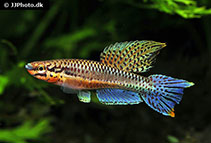| Family: |
Nothobranchiidae (African rivulines) |
| Max. size: |
50 cm TL (male/unsexed); 40 cm TL (female) |
| Environment: |
pelagic; freshwater; pH range: 5.69999980926514; depth range - 0 m, non-migratory |
| Distribution: |
Africa: known from a limited number of localities between Libreville and Cap Esterias in north-western Gabon (Ref. 80395) and Owendo area south of Libreville in Gabon (Ref. 119374). |
| Diagnosis: |
Dorsal spines (total): 0-0; Dorsal soft rays (total): 12-13; Anal spines: 0-0; Anal soft rays: 13-15; Vertebrae: 24-25. Diagnosis: This is a fairly large species of the subgenus Chromaphyosemion, larger than all its congeners with the exception of Aphyosemion riggenbachi, which has the most forward placed dorsal fin (Ref. 41203). It is a strictly blue phenotype with a unique red marking on the sides of the body with the exception of the gill lids, with two conspicuous, mood-dependent dark longitudinal bands, with a red dotted dorsal fin, a flamed caudal fin and an "undrawn" anal fin, except for a thin red submarginal and white marginal band, with longer trapezoidal vertical unpaired fins and a caudal fin with short extracts in the males; the female also shows the alpha-shaped mark, with striking, dark bandages and an anal fin without spots, but without a dark mesh pattern around the scales on the sides of the body (Ref. 41203).
Description: Large, somewhat stout with little lateral compression (Ref. 80395). Short streamers in dorsal end caudal fins; dorsal fin with 12-13 rays; anal fin with 13-15 rays; the ratio D/A = 1-2/1 (Ref. 80395). Scales in longitudinal series 25-26 (+1-2); predorsal scales 12-13; transversal scales 8-9 (Ref. 80395).
Colouration: Males light blue on flanks, light brown dorsally and pale orange yellow ventrally; dark red spots, forming horizontal bands dorsally on body and caudal peduncle; just above the pectoral fins two bands of red spots merge to form a larger spot in the shape of the Greek letter 'alpha'; throat usually pale orange; dorsal fin light orange, tinged with pale blue; large dark red spots between dorsal fin rays, with an orange short fin extension; anal fin blue, usually without dark red spots but some may be present basally; anal fin with a narrow dark red band and a light blue margin; caudal fin blue with dark red spots and stripes dorsally; in the lower part of this fin, a dark red band and light blue margin; caudal fin extensions orange (Ref. 80395). Young males with two dark longitudinal bands; when mature these bands are less visible (Ref. 80395). Females yellow-brown with two dark longitudinal bands that remain visible in mature specimens; all fins are colourless except the dorsal which is pale light blue with dark spots (Ref. 80395). |
| Biology: |
This species is found in clear creeks under forest cover, usually over a sandy soil, in the coastal plain (Ref. 80395). |
| IUCN Red List Status: |
Endangered (EN); Date assessed: 16 February 2009 (B1ab(iii)) Ref. (130435)
|
| Threat to humans: |
harmless |
| Country info: |
|
Source and more info: www.fishbase.org. For personal, classroom, and other internal use only. Not for publication.

